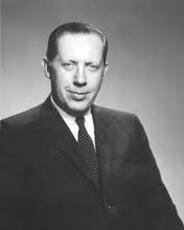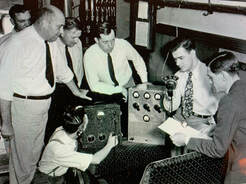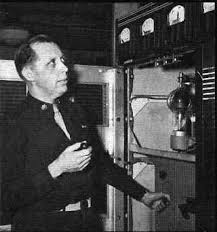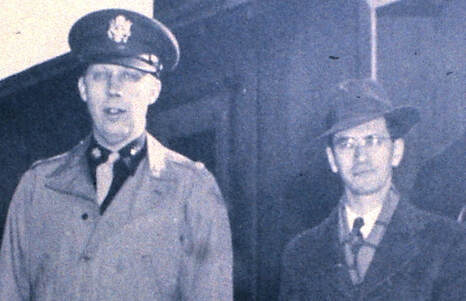
He was Nashville through and through, from his birth on February 20, 1906 to his death on January 22, 1999. His father was a judge in the Tennessee State Court of Appeals. He later attended Vanderbilt University and, after an interruption in 1929 to work in Bell Labs in Washington DC, in those days sort of a quasi-graduate school for aspiring engineers, he returned to complete his degree. For the rest of his life, he left Nashville only when he was needed elsewhere, and always returned when it became possible to do so.
 Jack DeWitt at WSM, standing 4th from left (Grand Ole Opry Archives)
Jack DeWitt at WSM, standing 4th from left (Grand Ole Opry Archives) At least temporarily, he was a military man - though perhaps less in the tradition of stoic and unquestioning obedience than in the macho Chuck Yeager tradition of having the “right stuff.” When WWII broke out, he left WSM and his beloved Nashville to answer the call of duty and join the Army, becoming a pioneer in the development of RADAR (an acronym only coined in 1940) when he was assigned to the Evans Signal Laboratory of the US Army in Belmar NJ. By 1943, at the age of 37, he had become Director of the Signal Laboratory, supervising the work of many thousands at employees at the height of WWII.
And on January 10, 1946, he accomplished the goal for which he will always be best remembered, when the Project Diana team he assembled after the War ended successfully bounced radar waves off the moon.

At any rate, the two men clearly worked superbly well together and forged a lasting bond, remaining in touch with one another until my father's death in 1992. I never heard my father speak of him with anything but the greatest affection.
As early as 1935, he attempted unsuccessfully to receive noise from the then newly-discovered Milky Way. Nothing daunted, he continued thinking about extraterrestrial communication, and by 1940, more specifically about the moon. On May 21, he famously wrote in his notebook: "It occurred to me that it might be possible to reflect ultrashort waves from the moon. If this could be done, it would open up wide possibilities for the study of the upper atmosphere. So far as I know, no one has ever sent waves off the Earth and measured their return through the entire atmosphere of the Earth." He went on to describe his attempt the previous evening to reflect 138 MHz (2-meter) radio waves off the moon, using an 80-watt transmitter and receiver he had developed and built for radio station WGN in Chicago. The experiment failed.
Fate handed DeWitt a second chance to attempt a moonbounce in 1945, when his demobilization was delayed for several months after World War II ended. He quickly assembled a small team of his most skilled engineers and gave them access to all of Camp Evans' resources, including in the Laboratory's Theoretical Studies Group (in particular the mathematician and astrophysicist Dr. Walter McAfee, without whose elegant computations of the velocity of a position on the moon relative to a position on earth, the project could not have succeeded), the Antenna and Mechanical Design Group, and others.
It was DeWitt who christened the experiment Project Diana, after the Roman goddess of the Moon, stating a little crudely, "the Greek [sic] mythology books said that she had never been cracked." His choice led to the American tradition, which continues to this day, of naming space missions after figures from ancient mythology.
To Jack DeWitt, failures were just speed bumps on the road to success. He thought about his "negative result" in 1940 and carefully considered how his little team could modify equipment already on hand - time was of the essence and funds were limited - to improve their chances of succeeding. The antenna and Dr McAfee's calculations needed to compensate for Doppler shift have been described elsewhere in this blog. To address the problem to which he primarily attributed his previous failure, insufficient receiver sensitivity, DeWitt settled on a crystal-controlled receiver and transmitter specially designed for the Signal Corps by radio pioneer Edwin H. Armstrong, to improve frequency stability. "We realized that the moon echoes would be very weak," he later recalled, "so we had to use a very narrow receiver bandwidth to reduce thermal noise to tolerable levels." They chose a wavelength of 2.7 meters - short enough, they believed, to penetrate the ionosphere.
Initial efforts to hit the moon were frustrated repeatedly, by dodgy equipment and possibly (as later suggested by team member Dr. Harold Webb) by their ignorance of a phenomenon known as the Faraday effect, which could cause the signals to be rotated as they passed through the ionosphere and escape detection.
Finally, on January 10, 1946, it all came together. The first signal was broadcast just before noon, and 2.5 seconds later - the amount of time required for a round trip of about 500,000 miles - the echoes lit up a 9" cathode-ray tube and produced an 180 Hz beep amplified by a loud speaker. Minutes later, when the moon moved out of range, testing ended for the day. Although the source of the echoes was inferential, DeWitt later remarked that it had to be the moon "because there was nothing else there but the moon."
Ironically, DeWitt himself wasn't present on that fateful day. "I was over in Belmar," he confessed later, "having lunch and picking up some items like cigarettes at the drug store (stopped smoking 1952 thank God)." Testing was repeated daily for the next 3 days, however, and then on eight additional days during the month, so he eventually had ample opportunity to enjoy the fulfillment of his dream.
The equipment, however, remained "haywire," as DeWitt put it, and some of the media excitement that followed was actually based on simulations, recordings, and scripted interviews. When a couple of prominent colleagues from the MIT Radiation Laboratory arrived to observe a test carried out under my father's direction, what happened was...nothing. As DeWitt recounted the story later, "You can imagine that at this point I was dying. Shortly a big truck passed by on the road next to the equipment and immediately the echoes popped up. I will always believe that one of the crystals was not oscillating until it was shaken up or there was a loose connection which fixed itself." Cheers erupted from the bystanders.
Such a project clearly needed a military justification, and DeWitt found it in a directive from the Army's Chief Signal Officer to develop radars capable of detecting missiles coming from the Soviet Union. Since no such missiles were available for tests, DeWitt argued, the Moon could serve as a handy stand-in. But DeWitt himself was more interested in its potential for space exploration, and radio man that he was, in the project's implications for communication. In his visionary notes of 1940, he wrote "There are times when communication by this method might be extremely valuable such as during magnetic storms and daytime radio "blackouts". This may provide a means in the future of bringing television programs over long distances, such as across the oceans." According to Harold Webb, Project Diana's potential for communication was still his obsession in 1945: "He thought TV signals could be bounced off the moon and spread to one-half the earth." Nary a word about its military implications was spoken, at least to those with whom he worked most closely.
Can a tower possibly be too tall?
DeWitt and his crew of engineers soon noticed that the tower was actually causing self-cancellation in its "fringe" reception areas, keeping it from reaching fans in Chattanooga and Knoxville, and in 1939 it was trimmed to a mere 808 feet. It is now known that the optimal height for a Class A station on that frequency is about 810 feet, so - close enough. The lopped-off portion was recycled as a flagpole at a nearby school, where it remained for more than 50 years.
During World War II, the tower was assigned to service as a backup relay station for transmissions to submarines should ship-to-shore communication be lost.
The tower, still standing proud just south of Nashville in Brentwood, has been designated a National Engineering Landmark and is listed in the National Register of Historic Places. In 2001, when the Country Music Hall of Fame and Museum moved to a new facility in the heart of downtown Nashville's arts and entertainment district, its design incorporated a replica of the distinctive diamond-shaped tower on top of the Rotunda, in recognition of WSM's revered place in country music history - thanks in no small part to its tower. It is among the oldest operating broadcast towers still in use, and for tower-philes everywhere, a must-see.


 RSS Feed
RSS Feed